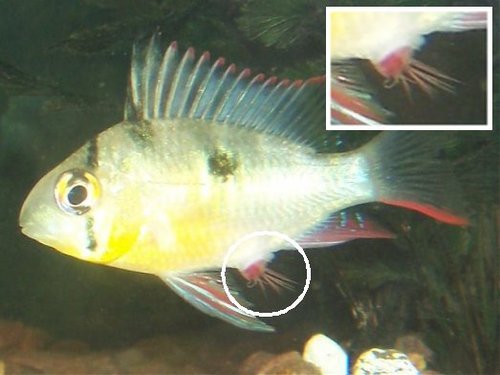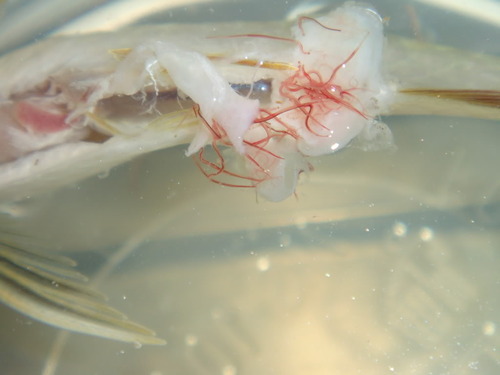Post with 78 notes
Camallanus worms
A parasiteyou should be aware of
Every
aquarist has his or her own personal nightmare disease. This can vary from
finrot and ich to pop-eye and dropsy. My personal fear is the camallanus worm. Unfortunately
I once had the misfortune to encounter this parasite. Fortunately I only ever had
to deal with one infection in the past 17 years and I’ve only lost one fish to
it. However to me the experience was horrifying enough.
Because I rarely ever see this parasite mentioned I’d like to share what I know about it so that if you ever encounter this worm you can recognise the signs and know how to treat your fish. Some of the pictures I’ve chosen to illustrate this disease are quite graphic.
What is the camallanus worm
The camallanus worms are actually a rather large family of internal parasites that have freshwater fish as hosts. They can infect both tropical and sub-tropical fish. Some worms specialise in a specific species, while other worms are more opportunistic and will infect nearly every kind of fish. However this parasite is most often associated with livebearers, South-American cichlids and loaches.

Mature worms are only a couple of millimetres long and bright red. They live in the intestines of fish where they feed on blood and irritate the digestive tract of the host.
Most camallanus worms usually need an intermediate host to be able to complete their reproductive cycle. This intermediate host is normally a small crustacean which is in turn eaten by the fish. However, some worms can skip this phase and their larva can spread directly to other fish through faeces or when other fish peck at a fish that has died from a camallanus infection. Some larva are even said to be able to survive for 3 weeks without a host. That’s why the entire tank should be treated in case of an infection.
Symptoms
The onset of an infestation can seem sudden, but in reality camallanus worms can take 6 to 12 weeks to grow large enough as individuals and as a colony to become noticeable. That’s one of the reasons why an infestation of camallanus worms doesn’t always come with obvious symptoms. For this reason it can’t hurt to perform an autopsy when many fish of different species start to die in rapid succession with no noticeable symptoms. If the fish’ stomach is filled with tiny red worms you’re dealing with a camallanus infection and the entire tank must be treated.
When symptoms do manifest you will usually see that the fish has a gaunt appearance, or a bloated stomach. With female livebearers it may look as though they are about to give birth, but the distension of their body lasts much longer than normal. A fish may also lose its appetite and sometimes you can see a red shine through the skin of the fish roughly where it’s stomach should be.

The most obvious sign is when the host has one or multiple red worms hanging from its anus. Even if there aren’t any worms visible, white stringy faeces is usually a sign of internal parasites of some kind.

A fish infected by camallanus worms may also die from a ruptured stomach when the host’s organs can’t contain the amount of worms anymore. This is how I lost a female guppy to camallanus worms. I was really lucky that I had mistook her infection for pregnancy and had quarantined her before she could infect any other fish.
Treatment
One nasty characteristic of camallanus worms is that they seem to be resistant to the more standard de-wormers on the market. However they can be treated with antihelminthic medication containing fenbendazole, levamisole or praziquantel. While these medications may not kill the worms, they can paralyse the parasites which results in them being expelled by the host. It is best to repeat the treatment three times, one week apart each. The gravel should also be thoroughly cleaned 24 hours after each treatment.
Antihelminthic medications are usualy toxic to snails and shrimp.
Recomended brands
Avitrol Plus
Colombo Dactycid
Prevention
There are generally three ways camallanus worms can be introduced to an aquarium. One way is by feeding your fish contaminated live food. That’s why it’s very important to check the source of live food. Crustaceans collected from ponds with fish in them may carry the larva of camallus worms.
Wild caught fish may also carry the parasite. This is why quarantine is extremely important, especially for wild caught fish.
It’s a bit more rare, camallanus larva can also be transferred from one tank to another by nets and other aquarium equipment. That’s why it’s important to at least rinse aquarium equipment after use. Especially if you have used it in a quarantine tank.
Sources
http://www.fishchannel.com/fish-health/freshwater-conditions/camallanus-worms.aspx
http://plecoplanet.com/?page_id=48
http://www.petfish.net/kb/entry/154/
http://www.fishlore.com/fishforum/freshwater-fish-disease/41023-how-get-rid-camallanus-nematode-worms.html
http://www.arofanatics.com/forums/showthread.php?t=449865&page=3
http://www.inkmkr.com/Fish/CamallanusTreatment/
j-frostik reblogged this from landofwaterandaquaria
j-frostik liked this
 melonfucker4 reblogged this from landofwaterandaquaria
melonfucker4 reblogged this from landofwaterandaquaria the-wolfgirl99 liked this
 seriousred liked this
seriousred liked this aquatictimes reblogged this from ifishgangsta
ifishgangsta reblogged this from aqua-naut
sskzzickk reblogged this from landofwaterandaquaria
lipid liked this
queen-of-the-surges liked this
fyeah-oldjapanesevrock liked this
all-my-friends-have-gills reblogged this from landofwaterandaquaria and added:
Ugh. I’ve dealt with these lil fuckers before. I had them in my 20 gal guppy tank. They came from a fish that I bought...
 yveltal69 liked this
yveltal69 liked this oeiceil reblogged this from iantojonesthebetta
crazyfishmaiden reblogged this from landofwaterandaquaria and added:
Levamisole….I can’t say it enough. It is the best medication if you know where and how to get to kill off these horrid...
sutoraberimiruku liked this
majestic-storm liked this
rippledmemories liked this
 cuaquaria reblogged this from landofwaterandaquaria and added:
cuaquaria reblogged this from landofwaterandaquaria and added: Having just recently dealt with this (and it is every bit as much of a nightmare as the OP says), REBLOG TO SAVE A FISH...
sapphirineskies liked this
yesanymorebrightideasgenius liked this
aquariumsforever reblogged this from landofwaterandaquaria
catburd-archive liked this
princesslassie liked this
aquasplendens liked this
 shark-hoarder liked this
shark-hoarder liked this iantojonesthebetta reblogged this from landofwaterandaquaria
 freyasalter reblogged this from landofwaterandaquaria
freyasalter reblogged this from landofwaterandaquaria izzy-the-fish-girl liked this
 polywoggiest reblogged this from landofwaterandaquaria
polywoggiest reblogged this from landofwaterandaquaria conrad-alarm-clock reblogged this from landofwaterandaquaria
conrad-alarm-clock liked this
catetharsis reblogged this from landofwaterandaquaria
kalicofish liked this
lightlaurein reblogged this from aqua-naut
biology-babe liked this
aqua-naut reblogged this from fail-joy
orchidsyogatea reblogged this from landofwaterandaquaria
orchidsyogatea liked this
- Show more notes